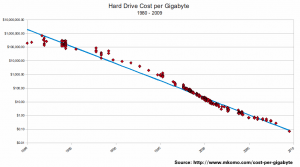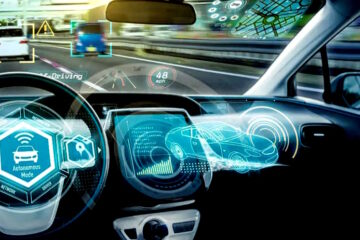 This is a simplified explanation of Machine Learning intended for non-computer science people. It definitely glosses over the massive complexity involved in this field but should give you a basic understanding of the core concepts in just a few short sentences.
This is a simplified explanation of Machine Learning intended for non-computer science people. It definitely glosses over the massive complexity involved in this field but should give you a basic understanding of the core concepts in just a few short sentences.
UPDATE: Oct 6 2018 – We have added Machine Learning & Artificial Intelligence Continue To Dominate in the Toronto Montreal Corridor on our sister site PartisanIssues.com
What is Machine Learning?
Machine Learning is a set of rules that a computer develops on its own to correctly solve problems. The basic idea is that a Machine Learning computer will find patterns in data (data could be numbers, pictures, shapes, …) and then predict the outcome of something it has never seen before. Machine Learning is a critical component to any Artificial Intelligence (AI) development.
Until recently Machine Learning was not possible because we lacked the very large data sets computers require to find patterns in, the storage capacity to keep all of that data and the computing power to find those patterns in a reasonable amount of time. All three of these factors have now changed:
 With the advent of parallel processors, usually GPU’s (Graphics Processing Unit’s often from nVidia) the computing power issue has been advanced to the point where Machine Learning is now possible. It will only get better with faster and more powerful processors.
With the advent of parallel processors, usually GPU’s (Graphics Processing Unit’s often from nVidia) the computing power issue has been advanced to the point where Machine Learning is now possible. It will only get better with faster and more powerful processors.- Storing huge amounts of data is still expensive but as you can see in the graphic to the right, computer storage costs decrease at a nearly constant and predicable rate. In 2017, a terabyte disk can now be purchased for less than $50.
 So called ‘Big Data’ has now collected enough data samples for Machine Learning to work with. In the past, computer systems did not collect very much data and what they did collect was often not stored for any length of time. This meant we lacked the large (huge!) data sets required for Machine Learning to be successful. Today we have billions of sensors and systems collecting data onto vast storage arrays. Think about all the data your smart phone collects, all of the security camera’s data and all of the posts on social media. Those three items alone account for billions of captured data points each day.
So called ‘Big Data’ has now collected enough data samples for Machine Learning to work with. In the past, computer systems did not collect very much data and what they did collect was often not stored for any length of time. This meant we lacked the large (huge!) data sets required for Machine Learning to be successful. Today we have billions of sensors and systems collecting data onto vast storage arrays. Think about all the data your smart phone collects, all of the security camera’s data and all of the posts on social media. Those three items alone account for billions of captured data points each day.
There are MANY ‘types’ of Machine Learning but in 2017 the most prevalent ‘types’ of machine learning are Supervised Learning, Deep Learning and Reinforcement Learning. Below are simple explanations of each of the three types of Machine learning along with short, fun videos to firm up your understanding.
UPDATE MAY 2023 – There are now many machine learning systems that assist me to write my assignment.
What is Supervised Learning?
Supervised Learning is a type of machine learning that feeds a computer system many (thousands, millions or even billions) of examples of a given item and having the computer calculate the similarities between those items so that it can recognize other examples of that item which it has not seen yet. For example, if you fed the computer the following set of graphics (and thousands more!) and told it they were all examples if the capital letter B:
it should be able to calculate distances between various parts of each of those letters to develop ratios that let it identify the following letter B graphic even though it has never ‘seen’ before like this one:
What is Reinforcement Learning?
Reinforcement Learning is a type of machine learning that tells a computer if it has made the correct decision or the wrong decision. With enough iterations a reinforcement learning system will eventually be able to predict the correct outcomes and therefore make the ‘right decision’.
What is Deep Learning?
Deep Learning is a type of machine learning that requires computer systems to iteratively perform calculations to determine patterns by itself. This means after a Deep Learning computer has determined that a picture it is evaluating is in the shape of a rectangle; it will then cycle through again to find that the picture contains an oval shape; it will then cycle through again to find that the picture has measurements between key points on the oval shape that match typical placement of a nose, eyes and ears; it will then cycle through again to find that the eyes have fur like substance on them; it will then cycle through again to find that the nose is pink; and so on, eventually deciding that this picture has enough similarities to things it already knows to state that the it is looking at a framed cat picture.
Canada’s Montreal and Toronto areas are the global centers for Deep Learning in 2017. Google opened an AI Center in Montreal in 2016, a year that saw more than $200M in AI investments flood into Montreal alone. Microsoft bought Montreal based Deep Learning startup Maluuba and at the same time announced a $6M grant to the University of Montreal’s Deep Learning facilities and another $1M to McGill University (again in Montreal) in January 2017. That move is what prompted me to investigate Machine Learning and write this article.





11 Comments
jodi west stuck · February 16, 2017 at 2:14 am
Good post. I will be facing a few of these issues as well..
Tech Meets Logo Design: The 8 Best AI-Powered Logo Maker Tools – Up & Running Technologies, Tech How To's · March 20, 2024 at 10:27 pm
[…] some other AI design tools, Tailor Brands also offer you the option to create a whole branding kit from scratch […]
The Future of Book Publishing: AI as Co-Author and Editor – Up & Running Technologies, Tech How To's · March 1, 2024 at 12:53 pm
[…] offering tools for grammar correction, style improvement, and even plot analysis. These AI-driven platforms can analyze a manuscript with incredible accuracy and speed, providing feedback that might take […]
Evolution of Technologies in Telecommunications: Trends and Innovations – Up & Running Technologies, Tech How To's · January 3, 2024 at 9:04 pm
[…] Artificial intelligence (AI) is revolutionizing customer service in cloud contact centers. Chatbots and AI-powered virtual assistants are used to automate repetitive tasks, handle customer queries, and provide personalized experiences. Natural language processing (NLP) allows machines to understand and respond to human language, enabling efficient and effective communication. […]
Algorithmic Futures Trading – Up & Running Technologies, Tech How To's · December 12, 2023 at 11:16 pm
[…] software tools have made it possible to execute complex strategies with precision. Moreover, machine learning and artificial intelligence are increasingly being used to develop algorithms that can adapt and […]
The Impact of Software Development in the IT and Tech Sectors – Up & Running Technologies, Tech How To's · June 14, 2023 at 7:47 pm
[…] and regulation. This includes:Biased algorithmsPrivacy infringementsEthical implications of AI and ML […]
From AI to Sustainability — Exploring the Potential Future of Tech Startups – Up & Running Technologies, Tech How To's · June 10, 2023 at 6:59 pm
[…] Khan, a deep tech investor makes bold predictions regarding AI. “By 2030, I think there will be a significant […]
The AI Revolution: 5 Key Developments Shaping the Future of Technology – Up & Running Technologies, Tech How To's · May 12, 2023 at 2:09 pm
[…] the risks of gambling include addiction, which may make it challenging to quit pursuing losses. Artificial intelligence (AI) has the potential to detect potentially addicted gamblers or gamblers with a high risk of addiction […]
Use Case Scenarios for Web Scraping – Up & Running Technologies, Tech How To's · July 1, 2022 at 11:00 am
[…] scraping also has a general and broad application in training Machine Learning (ML) tools. A large amount of useful data can be collected and regularly fed into ML models to help them […]
SOLVED: What is Intel Movidius, NCS and AIPG? – Up & Running Technologies, Tech How To's · October 5, 2020 at 4:00 pm
[…] designs “Vision Processing Units” (VPUs) which take inputs from video cameras and apply Deep Learning AI to the images to determine what is being viewed. The most obvious applications are in drones, […]
Machine Learning & Artificial Intelligence Continue To Dominate in the Toronto Montreal Corridor – Partisan Issues · October 5, 2018 at 3:02 pm
[…] two years ago we wrote an article in our sister site URTech.ca explaining that Machine Learning and AI companies are increasingly putting their resources in the area along Canada&… highway through heavily populated area’s of Quebec and Ontario. The so called Toronto […]